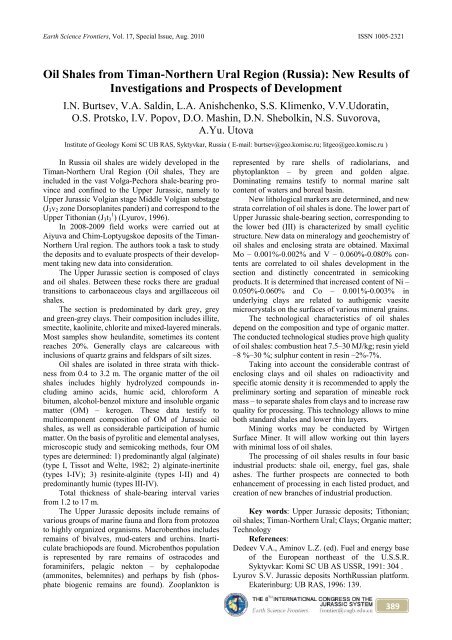in Jurassic and Cretaceous Stratigraphy
in Jurassic and Cretaceous Stratigraphy
in Jurassic and Cretaceous Stratigraphy
You also want an ePaper? Increase the reach of your titles
YUMPU automatically turns print PDFs into web optimized ePapers that Google loves.
Earth Science Frontiers, Vol. 17, Special Issue, Aug. 2010 ISSN 1005-2321<br />
Oil Shales from Timan-Northern Ural Region (Russia): New Results of<br />
Investigations <strong>and</strong> Prospects of Development<br />
I.N. Burtsev, V.A. Sald<strong>in</strong>, L.A. Anishchenko, S.S. Klimenko, V.V.Udorat<strong>in</strong>,<br />
O.S. Protsko, I.V. Popov, D.O. Mash<strong>in</strong>, D.N. Shebolk<strong>in</strong>, N.S. Suvorova,<br />
A.Yu. Utova<br />
Institute of Geology Komi SC UB RAS, Syktyvkar, Russia ( E-mail: burtsev@geo.komisc.ru; litgeo@geo.komisc.ru )<br />
In Russia oil shales are widely developed <strong>in</strong> the<br />
Timan-Northern Ural Region (Oil shales, They are<br />
<strong>in</strong>cluded <strong>in</strong> the vast Volga-Pechora shale-bear<strong>in</strong>g pro-<br />
v<strong>in</strong>ce <strong>and</strong> conf<strong>in</strong>ed to the Upper <strong>Jurassic</strong>, namely to<br />
Upper <strong>Jurassic</strong> Volgian stage Middle Volgian substage<br />
(J3v2 zone Dorsoplanites p<strong>and</strong>eri) <strong>and</strong> correspond to the<br />
Upper Tithonian (J3t3 1 ) (Lyurov, 1996).<br />
In 2008-2009 field works were carried out at<br />
Aiyuva <strong>and</strong> Chim-Loptyugskoe deposits of the Timan-<br />
Northern Ural region. The authors took a task to study<br />
the deposits <strong>and</strong> to evaluate prospects of their develop-<br />
ment tak<strong>in</strong>g new data <strong>in</strong>to consideration.<br />
The Upper <strong>Jurassic</strong> section is composed of clays<br />
<strong>and</strong> oil shales. Between these rocks there are gradual<br />
transitions to carbonaceous clays <strong>and</strong> argillaceous oil<br />
shales.<br />
The section is predom<strong>in</strong>ated by dark grey, grey<br />
<strong>and</strong> green-grey clays. Their composition <strong>in</strong>cludes illite,<br />
smectite, kaol<strong>in</strong>ite, chlorite <strong>and</strong> mixed-layered m<strong>in</strong>erals.<br />
Most samples show heul<strong>and</strong>ite, sometimes its content<br />
reaches 20%. Generally clays are calcareous with<br />
<strong>in</strong>clusions of quartz gra<strong>in</strong>s <strong>and</strong> feldspars of silt sizes.<br />
Oil shales are isolated <strong>in</strong> three strata with thick-<br />
ness from 0.4 to 3.2 m. The organic matter of the oil<br />
shales <strong>in</strong>cludes highly hydrolyzed compounds <strong>in</strong>-<br />
clud<strong>in</strong>g am<strong>in</strong>o acids, humic acid, chloroform A<br />
bitumen, alcohol-benzol mixture <strong>and</strong> <strong>in</strong>soluble organic<br />
matter (OM) – kerogen. These data testify to<br />
multicomponent composition of OM of <strong>Jurassic</strong> oil<br />
shales, as well as considerable participation of humic<br />
matter. On the basis of pyrolitic <strong>and</strong> elemental analyses,<br />
microscopic study <strong>and</strong> semicok<strong>in</strong>g methods, four OM<br />
types are determ<strong>in</strong>ed: 1) predom<strong>in</strong>antly algal (alg<strong>in</strong>ate)<br />
(type I, Tissot <strong>and</strong> Welte, 1982; 2) alg<strong>in</strong>ate-<strong>in</strong>ert<strong>in</strong>ite<br />
(types I-IV); 3) res<strong>in</strong>ite-alg<strong>in</strong>ite (types I-II) <strong>and</strong> 4)<br />
predom<strong>in</strong>antly humic (types III-IV).<br />
Total thickness of shale-bear<strong>in</strong>g <strong>in</strong>terval varies<br />
from 1.2 to 17 m.<br />
The Upper <strong>Jurassic</strong> deposits <strong>in</strong>clude rema<strong>in</strong>s of<br />
various groups of mar<strong>in</strong>e fauna <strong>and</strong> flora from protozoa<br />
to highly organized organisms. Macrobenthos <strong>in</strong>cludes<br />
rema<strong>in</strong>s of bivalves, mud-eaters <strong>and</strong> urch<strong>in</strong>s. Inarti-<br />
culate brachiopods are found. Microbenthos population<br />
is represented by rare rema<strong>in</strong>s of ostracodes <strong>and</strong><br />
foram<strong>in</strong>ifers, pelagic nekton – by cephalopodae<br />
(ammonites, belemnites) <strong>and</strong> perhaps by fish (phos-<br />
phate biogenic rema<strong>in</strong>s are found). Zooplankton is<br />
represented by rare shells of radiolarians, <strong>and</strong><br />
phytoplankton – by green <strong>and</strong> golden algae.<br />
Dom<strong>in</strong>at<strong>in</strong>g rema<strong>in</strong>s testify to normal mar<strong>in</strong>e salt<br />
content of waters <strong>and</strong> boreal bas<strong>in</strong>.<br />
New lithological markers are determ<strong>in</strong>ed, <strong>and</strong> new<br />
strata correlation of oil shales is done. The lower part of<br />
Upper <strong>Jurassic</strong> shale-bear<strong>in</strong>g section, correspond<strong>in</strong>g to<br />
the lower bed (III) is characterized by small cyclitic<br />
structure. New data on m<strong>in</strong>eralogy <strong>and</strong> geochemistry of<br />
oil shales <strong>and</strong> enclos<strong>in</strong>g strata are obta<strong>in</strong>ed. Maximal<br />
Мо – 0.001%-0.002% <strong>and</strong> V – 0.060%-0.080% con-<br />
tents are correlated to oil shales development <strong>in</strong> the<br />
section <strong>and</strong> dist<strong>in</strong>ctly concentrated <strong>in</strong> semicok<strong>in</strong>g<br />
products. It is determ<strong>in</strong>ed that <strong>in</strong>creased content of Ni –<br />
0.050%-0.060% <strong>and</strong> Co – 0.001%-0.003% <strong>in</strong><br />
underly<strong>in</strong>g clays are related to authigenic vaesite<br />
microcrystals on the surfaces of various m<strong>in</strong>eral gra<strong>in</strong>s.<br />
The technological characteristics of oil shales<br />
depend on the composition <strong>and</strong> type of organic matter.<br />
The conducted technological studies prove high quality<br />
of oil shales: combustion heat 7.5–30 MJ/kg; res<strong>in</strong> yield<br />
–8 %–30 %; sulphur content <strong>in</strong> res<strong>in</strong> –2%-7%.<br />
Tak<strong>in</strong>g <strong>in</strong>to account the considerable contrast of<br />
enclos<strong>in</strong>g clays <strong>and</strong> oil shales on radioactivity <strong>and</strong><br />
specific atomic density it is recommended to apply the<br />
prelim<strong>in</strong>ary sort<strong>in</strong>g <strong>and</strong> separation of m<strong>in</strong>eable rock<br />
mass – to separate shales from clays <strong>and</strong> to <strong>in</strong>crease raw<br />
quality for process<strong>in</strong>g. This technology allows to m<strong>in</strong>e<br />
both st<strong>and</strong>ard shales <strong>and</strong> lower th<strong>in</strong> layers.<br />
M<strong>in</strong><strong>in</strong>g works may be conducted by Wirtgen<br />
Surface M<strong>in</strong>er. It will allow work<strong>in</strong>g out th<strong>in</strong> layers<br />
with m<strong>in</strong>imal loss of oil shales.<br />
The process<strong>in</strong>g of oil shales results <strong>in</strong> four basic<br />
<strong>in</strong>dustrial products: shale oil, energy, fuel gas, shale<br />
ashes. The further prospects are connected to both<br />
enhancement of process<strong>in</strong>g <strong>in</strong> each listed product, <strong>and</strong><br />
creation of new branches of <strong>in</strong>dustrial production.<br />
Key words: Upper <strong>Jurassic</strong> deposits; Tithonian;<br />
oil shales; Timan-Northern Ural; Clays; Organic matter;<br />
Technology<br />
References:<br />
Dedeev V.A., Аm<strong>in</strong>ov L.Z. (ed). Fuel <strong>and</strong> energy base<br />
of the European northeast of the U.S.S.R.<br />
Syktyvkar: Komi SC UB AS USSR, 1991: 304 .<br />
Lyurov S.V. <strong>Jurassic</strong> deposits NorthRussian platform.<br />
Ekater<strong>in</strong>burg: UB RAS, 1996: 139.<br />
389

















